Will It Lens? Part 4
If you’ve missed it, here are parts one, two, and three of our adventures with a 4’x3′ fresnel lens, along with a gallery of all the pictures.
Our lens arrived with a corner chipped off, so the lens company sent us a second one for free (which also had its corner chipped off on arrival, but we didn’t get a third for free). I’ve been holding off writing this post because I was hoping to title it “Episode IV: A New Lens,” but we still haven’t built the frame for the second lens or the frame for the mirrors that will reflect light from both lenses onto a single point. So, instead of waiting for that to happen, I’m posting the results I’ve already got.
The same SAFETY NOTES as before apply, as always. In lieu of new safety warnings (we haven’t had any new dangers come up!), I’ve got a few tips for anyone trying to duplicate this.
- Build your stand taller than you think you need. When daylight savings time kicked in, the sun was suddenly much higher in the sky during lunch, so we tilted our lens more horizontally to face the sun, and the focal point was in the floor. I don’t think we’ve seriously damaged the floor, but things would work much better if we had a patch of (unburnable) dirt to hold our equipment. We’ve adjusted the legs of our stand to be taller than they were before.
- Get very strong filters for your welding goggles (I know I said this last time, but it’s worth repeating). We started out with #5 filters, which definitely aren’t strong enough, but we’ve upgraded to a #12 filter, which lets you stare at things in the focal point without hurting your eyes. The one tricky thing is that you can’t see anything else with them, so you’re basically blind from the time you put your goggles on until the time we take the cardboard off the lens and let light through it. but the new filter has really helped people positioning the skillet, since they can see what they’re doing.
- Build a lens frame that would be structurally sound even without a lens in it. Our “frame” was 4 boards that were attached to the edges of the lens. This kept it nice and flat, but if you pick it up by the wood, you exert a lot of strain on the lens, and we have a crack in a corner because of this strain. We’ve got L-brackets now to secure the boards to each other, so hopefully the crack won’t worsen.
- Expect that anything you stick in the focal point might be ruined. Even though we can’t melt iron, we got the skillet so hot that it spontaneously rusted in a couple places. I don’t think it’s rusted all the way through, but we definitely have rust spots on the top and corresponding rust spots on the bottom. I now owe Jacob a new skillet. We also have burn marks on the Leatherman we had been using as pliers (luckily they come with a lifetime warranty, so I think we can get those fixed). So, expect that anything you put in the focal point may get ruined by the experience.
- Go shopping for aluminum foil. We went to the store and found some cheap foil without any non-stick coating that had the advantage of being “heavy duty.” Since it’s just aluminum without any weird chemicals on the surface, it seems preferable to the stuff we had been using before.
- If you intend to eat anything you make, use a clean surface to cook it (another repeat from last time, but worth the reiteration). This should go without saying, but we thought we were pretty clever when we lined the skillet with aluminum foil, so that our food didn’t come into contact with the copper oxide and other nasty things we’d put in it previously. Things like metals and plastics solidify at room temperature (obviously) and stick to whatever they had melted onto, so they’re hard to wash away, even if you clean the skillet thoroughly. A fresh lining of aluminum foil removes any doubt about whether there are still carcinogens/irritants touching your food.
On to the results!
Here’s a question for the physicists and/or chemists out there: when we put a piece of wood in the focal point, it caught fire immediately (with red flames, though they don’t show up well in the picture),
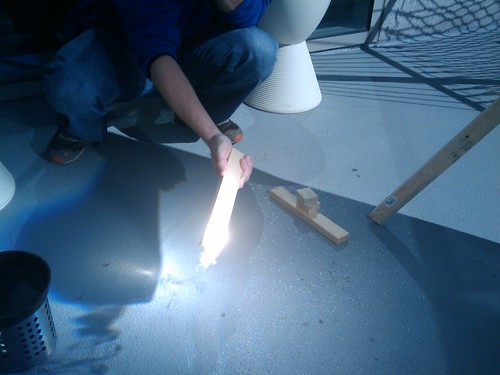
but when we took it back out, the flames went out immediately, too.

Why didn’t the wood keep burning like a normal fire? When we take paper out of the focal point, it continues to burn and we need to douse it with a cup of water, and I can’t explain why that doesn’t happen with the wood.
We’d had such good luck with pennies and interesting luck with dimes, we tried a quarter. Parts of it turned black (just like the other coins), but parts turned a red-brown rusty color. We’re not sure what that is; oxidized copper is black and oxidized zinc is white, and there shouldn’t be any iron in the quarter, so we don’t know what happened there.
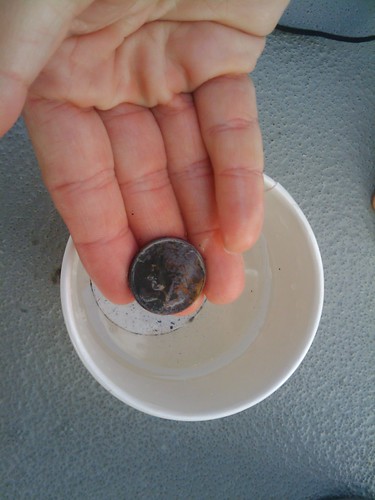
iguanawow suggested we try soap, hoping for similar results to putting soap in a microwave. Thanks for the suggestion; it totally worked!
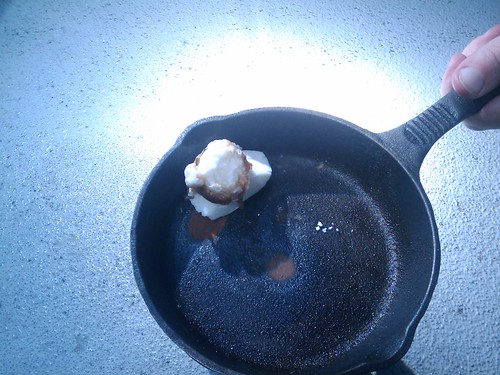
The soap at the focal point foamed up, then the foam broke and melted and flowed down the side of the solid bar, and kinda burned and turned brownish. and the cool thing about this is that as the foam gave way and the liquid flowed out of the focal point, the light could reach new soap, and this continued in perpetuity.
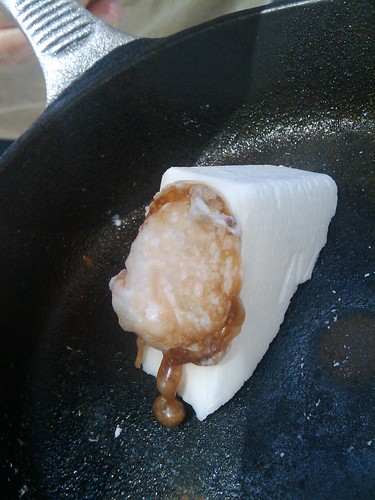
I suspect there’s a lot of air in there, because it was cool to the touch ~20 seconds after taking it out of the light. At that point, the foam felt kinda like marshmallows (incidentally, marshmallows are near the top of our list of things to try next). Several hours later, however, the soap had become hard again and was no longer squishy to the touch.

The bar of soap worked so well, we tried liquid dishwasher detergent. It foamed into a shallow layer of tiny bubbles.
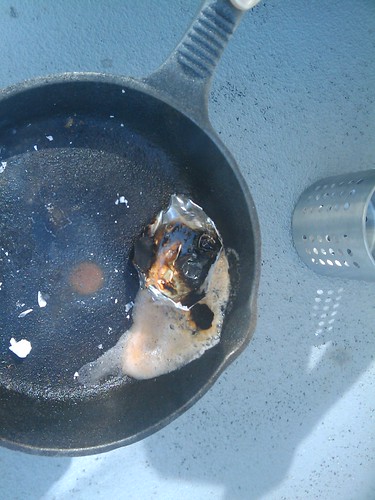
It smelled both lemony fresh and very bad for you in that cleaning solution sort of way, just like you’re used to.
Despite our mixed success with foods so far, we decided to try cooking bacon.

This picture was taken using the #5 welding goggles which is why the pan is half visible but still so blindingly bright; the #12 goggles are always reserved for the person holding the skillet.

The problem with cooking with the lens is that it heats stuff up too hot too fast. So, about a third of the bacon was well done, a third was burnt, and a third was uncooked. Also, we had a huge pool of bacon grease in the bottom of the skillet. but the well-cooked parts tasted great. So, we added an egg.

The egg was covered in the bacon fat, and was delicious. We didn’t lens the spoon; we used it to eat the egg afterwards.
We tried honey, which boiled very vigorously.
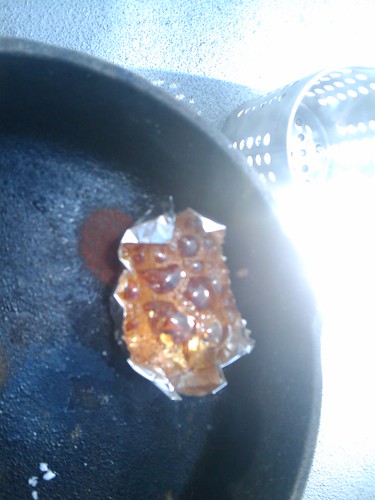
It smelled delicious. After a while, though, it burned, turned black, and smelled terrible. I suspect caramelized honey contains lots of large polymers (or similar molecules), because it was stretchy and solid at the same time (part stuck to the skillet and stretched into really long wisps as we picked it up).
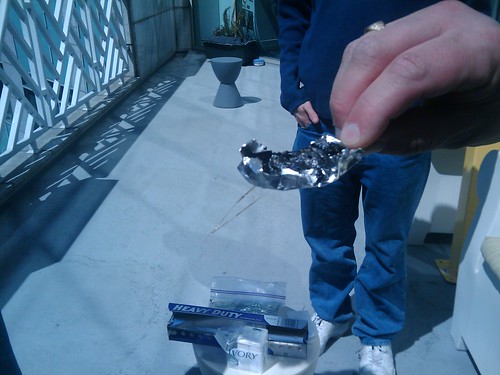
We had mussels for dinner one night, so we saved an empty shell to lens.
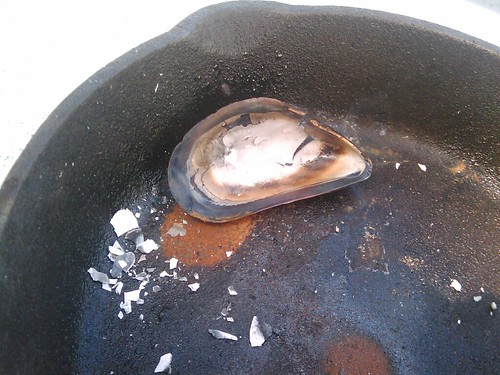
The inside used to be all white (like the rightmost area), but it turned brownish/blackish and then a very ashen white. The top started out completely black, but turned white as it burned (which smelled just as bad as you’d imagine a dead, burning shellfish would). The shell is composed of layers, and they started flaking off both the top and bottom. We also cracked the shell pretty badly; not sure if that was some internal stress in the shell that had always been there, or if heating it caused the hot parts to expand and crack away from the less hot parts. However, the whole thing became so brittle that large pieces fell off at the slightest touch.

Seashells are mostly calcium carbonate (aka limestone), which decomposes around 1100K, which is totally a temperature we can reach (particularly with a nonreflective black object, since it absorbs most of the light). I suspect the white parts are calcium, but I have no idea what carbonate looks like or whether it’s still there somewhere.
Almonds smoked a lot, but I don’t think they produced any flames.
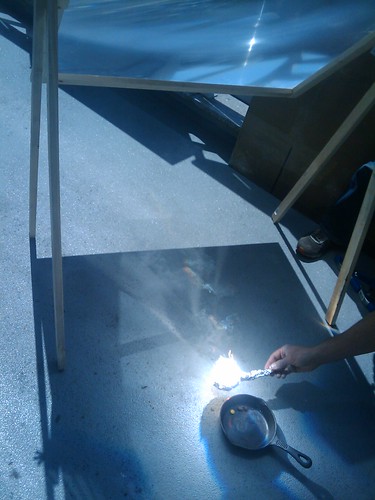
Afterwards, they were very black (no surprise there).
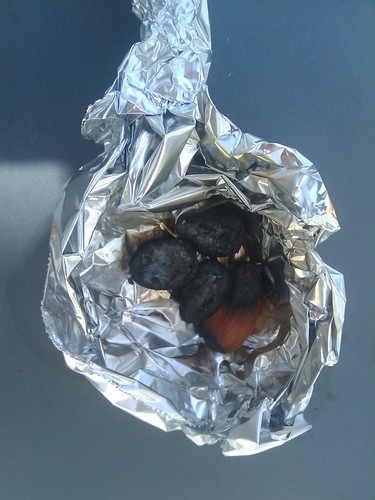
We tried toasting a sandwich, but that didn’t work well. In order not to burn it, we kept it away from the focal point, so that the light was more diffuse. After several minutes, the top of the bread was kinda toasted, but I’d recommend going back to your toaster oven or panini press or whatever you typically use to cook sandwiches.
We tried gummy bears, expecting them to behave like jelly beans. However, we couldn’t have been more wrong! They foamed up.

In fact, they foamed up so much that they overflowed the aluminum foil holder. However, the foam collapsed back into its normal, gummy state very quickly as it cooled down.

Afterwards, it didn’t look significantly different from the way it started (other than losing the bear shape and melting into one big glob). We weren’t brave enough to eat it, but we might try that at some point in the future.
M&Ms smoked away their color, and then burned into black lumps.

Unlike the Reeses Pieces from my previous post, the candy shell and chocolate contents didn’t noticeably separate out into distinct layers.
As always, if you have ideas of stuff to lens, I’d be happy to try them out. Until next time, be safe and have fun!
Edit: In part 5 we achieve much higher temperatures!
I’ve totally got a craving for Smores now.
Burning Wood
Sometimes when you try to light a piece of wood on fire it burns when directly exposed to flame but then goes out when the flame is removed. I would be interested to know if you took that same piece of wood and held a match to it for a comparable amount of time and then removed the match if the wood would keep burning.
I think this might have something to do with moisture in the wood, but it could be something else.
Re: Burning Wood
Most matches would go out long before the wood caught. We tried more wood recently, and the trick is that once you got the wood burning for long enough (5-10 seconds), it stayed lit, even with the wind.
Re: Burning Wood
Really? I remember trying it a second time, and having the flames go out a second time. Did you try this on one of the days I missed?
Troy thinks the wood went out because the light could only heat up the top, and after that burned the rest was still at room temperature and not hot enough to burn.
Re: Burning Wood
We did the wood after you went in this most recent time. By keeping the light on it for longer, I suspect that we got the wood hot enough to continue burning.
Burning wood and paper
I sent this to you as a message on live journal, before i got to the end of the page and found these comments :) I’ll post it here for everyone else’s benefit too.
“
Its all do do with “Activation energy”. basically, each element has its own activation energy, the energy required for that element to bond with another. this much energy must be put in for the element to react. fire is just a chemical reaction, the red/orange you see is just very hot carbon atoms reaction with Oxygen to become carbon dioxide.
the wood has a higher activation energy than the paper. so the paper fire is started by the energy given to it by the light, and then it is able to self propagate because the energy released by the reaction, is enough to cause another reaction, and so on.
with the wood, the energy released by one reaction is not enough to cause another, so removing it from the main source of energy, the light, causes the fire to go out.
hope that answers your question.
“
Re: Burning Wood
The problem is that there is still a tiny amount of water in the wood. If you take the wood out immediately, not enough water has evaporated around the “hot spot,” and the fire goes out. You either need to use EXTREMELY dry wood, or establish a “chain reaction” where the heat from the fire is enough to dry the surrounding wood.
Re: Burning Wood
There is no activation energy in it. Cellulose is cellulose, whether in wood or paper. The trick is in the thickness. The paper is thin, and its own flame easily heats it up to the temperature where it burns. The wood on the other hand is thicker and has water in it, and evaporation cools down things immensely. You can light a 2×4 on fire with a match (theoretically), but it’s gonna take a while as the wood needs to heat up enough so that it doesn’t cool down below burning temperature as soon as you remove the external heat source.
Re: Burning Wood
Setting a piece of wood on fire with a lens basically means you’re focusing light on a single point. The surrounding mass of wood is not heating up in that setup.
For something to burn it needs to have 3 things –
1) high temperature
2) Oxygen
3) Fuel
The wood is really hot only at the point where the sunlight is focused.
Wood is a bad conductor – thus the heat from that single point does not travel through its length very well. The flame at the point of exposure is not big enough to heat up the surrounding mass of wood fast enough to spread the flame before it goes out.
Paper on the other hand is thin enough for the heat to spread through to the immediately surrounding region quickly enough. And it also has better exposure to Oxygen as it is fed air on both surfaces.
That picture of the exploded soap is so gnarly. It’s like it just imploded into some hideous x-dimension of soap-marshmallows, caught in the space in between.
Yeah, that’s my favorite, too! I had the soap and mussel shell on a napkin on my desk, and the janitors came by at night and decided it was trash and threw it out. but then we lensed a second bar of soap, so I’ve got another one.
Cooking
I hope all that vaporized aluminum has no ill effects.
Have you tried lensing the iron skillet instead of the food directly and letting the conducted heat do the cooking?
Cooking an egg?
What about trying to cook an egg. With the shell on and all…
Re: Cooking an egg?
Nope. It’s likely to explode, and we don’t want to egg our own office. However, we plan on lensing an (empty) eggshell sometime soon.
Suggestion…
How about a can of soda, unopened???
How about try cooking an iPhone?
Things I’d love to see lensed:
– soil. All sorts: will really black earth get much hotter then all the lighter colored stuff and do.. whatever it may do? Will pure sand become glass (or circuit boards? ;)
– try cooking for real: try to come up with something to turn this energy into a way to actually heat a pan/… (Boil water, put the pan into the water? but that will reach only 100C, how could you reach eg 200C?)
– soda can indeed (use a sparkling water can ;) and video it!
– asphalt?
We had considered soil, but decided not to because it isn’t likely to do anything (dirt doesn’t get changed in a forrest fire; why would it do something here?). Sand is typically silicon dioxide (aka quartz), which melts at 1996 K. If we can’t melt copper at 1356 K, we can’t melt sand.
The asphalt is a great idea; I’ve added it to our list of stuff to try. Thanks!
Diet Coke and Mentos
Try Diet Coke and Mentos :)
Can you melt glass?
Re: Diet Coke and Mentos
We can try them each individually, but I’m not sure how we’re supposed to lens a fountain of diet Coke spewing through the air (particularly if we want to clean everything up before lunch is over). …actually, it might be pretty cool to lens Coke and see how quickly we can get the dissolved carbon dioxide to come out. I’ll add it to the list.
Cooking
As you’ve noted, cooking is difficult because the heat is too concentrated. Cooking vessels are good at spreading heat. Maybe if you pointed the lens at a mirror (half way down the focus point), so that you can get the focus of the lens on the bottom of the pan you might have better luck cooking.
How about putting it in a window and using it to heat your coffee
.
Re: How about putting it in a window and using it to heat your coffee
The very first sentence of the very first safety note says not to store it in a sunny place, because as the day progresses, the sun moves, so the focal point moves, and then your desk is on fire. If there is sunlight shining on the lens, it should be actively monitored so that you don’t burn the building down.
Hrm….
Wonder what would happen if you were to lens jello?
Also, what about watermelon or dried ice?